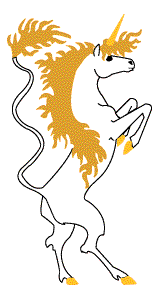| Revision as of 16:10, 2 September 2003 view sourceJose Ramos (talk | contribs)1,444 editsm move pic into text← Previous edit | Revision as of 06:14, 27 October 2003 view source Pedant17 (talk | contribs)5,619 edits edNext edit → | ||
| Line 1: | Line 1: | ||
| ] ] ] ] ] | ] ] ] ] ] | ||
| The '''unicorn''' is a ] shaped like a horse but with a single |
The '''unicorn''' is a ] shaped like a horse but with a single - usually spiral - ] growing out of its forehead. Some accounts describe it as having the body of a deer and the head of a lion. | ||
| <div style="float:right;margin-left:1em;">]</div> | <div style="float:right;margin-left:1em;">]</div> | ||
| The unicorn was a common symbol during the ], appearing on many ]. It may have |
The unicorn was a common symbol during the ], appearing on many ]. It may have symbolised a powerful group. | ||
| Ancient Greek accounts of unicorns locate their habitat in India. The unicorn did not appear in Greek ], but as an actual - albeit exotic - beast. | |||
| ⚫ | In medieval times, |
||
| ⚫ | In medieval times, ]s would occasionally manufacture a unicorn by surgery on a ] kid: they would remove one horn bud and relocate the other to the centre of the forehead. (This technique continued to as recently as the 20th century, for circus displays.) ] tusks, however, provided the main source of "unicorn" horns. | ||
| Unicorn horns were commonly believed to be able to neutralize poisons. Therefore, people who feared poisoning sometimes drank from goblets made of "unicorn horn". | |||
| In popular belief, unicorn horns could neutralize poisons. Therefore, people who feared poisoning sometimes drank from goblets made of "unicorn horn". Alleged ] qualities and other purported medicinal virtues also drove up the cost of "unicorn" products such as milk, hide and offal. | |||
| ⚫ | The unicorn |
||
| ⚫ | The unicorn also served as a common symbol of purity and of ]. The traditional method of hunting unicorns involved entrapment by a ]. | ||
| The unicorn also functions as a national symbol of ] and appears on many British symbols, notably as a ] of ]. | |||
| In ] fiction, a unicorn often has ] qualities or powers. | In ] fiction, a unicorn often has ] qualities or powers. | ||
| The constellation ] represents a unicorn. | The ] ] represents a unicorn. | ||
Revision as of 06:14, 27 October 2003
The unicorn is a legendary creature shaped like a horse but with a single - usually spiral - horn growing out of its forehead. Some accounts describe it as having the body of a deer and the head of a lion.

The unicorn was a common symbol during the Indus Valley Civilisation, appearing on many seals. It may have symbolised a powerful group.
Ancient Greek accounts of unicorns locate their habitat in India. The unicorn did not appear in Greek mythology, but as an actual - albeit exotic - beast.
In medieval times, entrepreneurs would occasionally manufacture a unicorn by surgery on a goat kid: they would remove one horn bud and relocate the other to the centre of the forehead. (This technique continued to as recently as the 20th century, for circus displays.) Narwhal tusks, however, provided the main source of "unicorn" horns.
In popular belief, unicorn horns could neutralize poisons. Therefore, people who feared poisoning sometimes drank from goblets made of "unicorn horn". Alleged aphrodisiac qualities and other purported medicinal virtues also drove up the cost of "unicorn" products such as milk, hide and offal.
The unicorn also served as a common symbol of purity and of Jesus Christ. The traditional method of hunting unicorns involved entrapment by a virgin.
The unicorn also functions as a national symbol of Scotland and appears on many British symbols, notably as a supporter of coats of arms.
In fantasy fiction, a unicorn often has magical qualities or powers.
The constellation Monoceros represents a unicorn.